
Phyllomedusa burmeisteri, also known as Burmeister's leaf frog and common walking leaf frog, is a species of frog native to the Atlantic Forest biome in Brazil.

Phyllomedusa bicolor, the giant leaf frog, bicolor tree-frog, giant monkey frog, or waxy-monkey treefrog, is a species of leaf frog. It can be found in the Amazon basin of Brazil, Colombia (Amazonas), Bolivia, and Peru, and can also be found in the Guianan Region of Venezuela and the Guianas, and in Cerrado of the state of Maranhão in Brazil.
Leucostethus argyrogaster or the Imaza rocket frog is a species of frog in the family Dendrobatidae. It is endemic to Peru.
Hyloxalus toachi is a species of frog in the family Dendrobatidae. It is endemic to northwestern Ecuador.

Agalychnis dacnicolor, the Mexican leaf frog, is a species of frog in the subfamily Phyllomedusinae. It is endemic to Mexico.
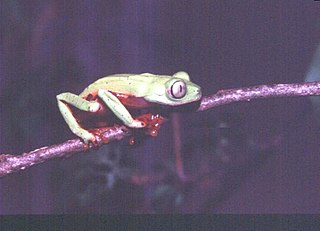
Phasmahyla cochranae, sometimes called the chocolatefoot leaf frog, is a species of frog in the subfamily Phyllomedusinae. It is endemic to Brazil. People have seen it between 800 and 1600 meters above sea level.

Callimedusa atelopoides is a species of frog in the subfamily Phyllomedusinae. It is known from Amazonian Bolivia, Brazil, and Peru, and is likely to be found in adjacent Colombia and Ecuador. Common name toady leaf frog has been proposed for it.
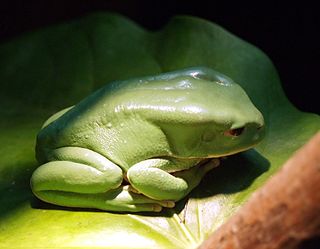
Phyllomedusa boliviana is a species of frog in the subfamily Phyllomedusinae. It is found in Argentina, Bolivia, and Brazil. It has been observed between 200 and 1800 meters above sea level.

Phyllomedusa camba or the black-eyed monkey frog is a species of frog in the subfamily Phyllomedusinae. It is found in Bolivia, Brazil, and Peru. It has been observed between 280 and 1000 meters above sea level.
Phyllomedusa coelestis is a species of frog in the subfamily Phyllomedusinae. It is found in Colombia, Ecuador, and Peru between 200 and 1000 meters above sea level.

Callimedusa ecuatoriana is a species of frog in the subfamily Phyllomedusinae. It is endemic to Ecuador and known from the Amazonian slopes of the Andes in the Morona-Santiago Province as well as from Cordillera del Condor in the Zamora-Chinchipe Province. Common name Agua Rica leaf frog has been proposed for it.
Callimedusa perinesos is a species of frog in the subfamily Phyllomedusinae. It is found on the Amazonian slopes of the Andes in Colombia and Ecuador. Common name orange-spotted leaf frog has been proposed for it.

Callimedusa tomopterna, the tiger-striped tree frog, is a species of frog in the subfamily Phyllomedusinae. It is found in northern South America in the Upper Amazon Basin of Bolivia, Peru, Ecuador, and Colombia, Amazonian Brazil, and the Guianas from southeastern Venezuela to French Guiana. It might represent more than one species.
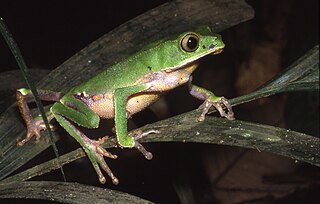
The white-lined leaf frog is a species of frog in the subfamily Phyllomedusinae. It is found in northern South America. Its natural habitats are subtropical or tropical moist lowland forest, subtropical or tropical swampland, rivers, and freshwater marshes. It is threatened by habitat loss.
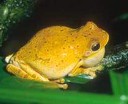
The mahogany tree frog is a species of frog in the family Hylidae found in Belize, Costa Rica, Guatemala, Honduras, Mexico, and Nicaragua.

Taruga eques is a species of tree frog in the family Rhacophoridae. It is endemic to the central hills of Sri Lanka.
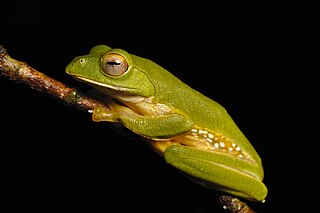
Rhacophorus pseudomalabaricus, also known as Anaimalai flying frog, false Malabar gliding frog, and false Malabar tree frog, is a species of frog in the family Rhacophoridae. It is endemic to the Anaimalai Hills, a part of the southern the Western Ghats in the Tamil Nadu and Kerala states, India.
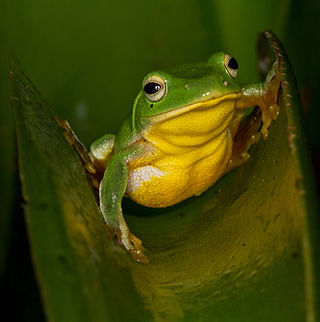
The Taipei tree frog is a species of frog in the family Rhacophoridae. It is endemic to central and northern Taiwan. It is a medium-sized tree frog; females are 4.5–5.5 cm (1.8–2.2 in) in snout-vent length, and males are slightly smaller 3.5–4.5 cm (1.4–1.8 in).
Phyllomedusa chaparroi is a species of treefrog in the subfamily Phyllomedusinae endemic to Peru. Scientists have only seen it in two places. This frog has been observed between 537 and 650 meters above sea level.
Silverstoneia minutissima is a species of frog in the family Dendrobatidae. It is endemic to Colombia, in such places as Chocó, Alto del Buey, Río Atrato, and Río San Juan.















